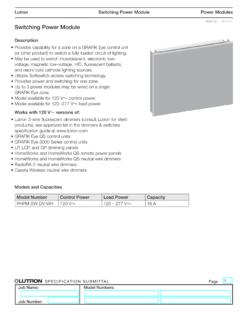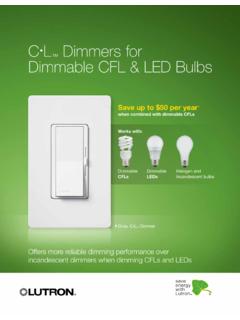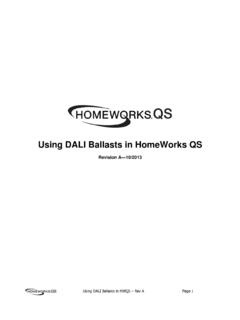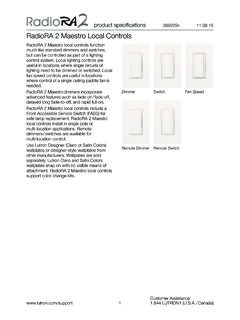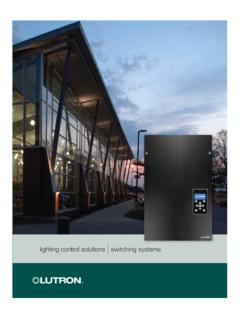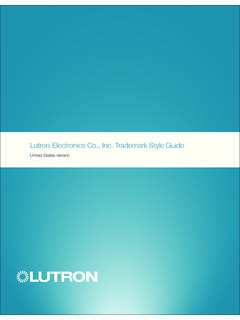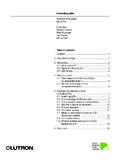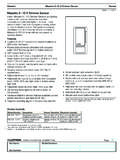Transcription of February 2018 0-10 V Control Topology - Lutron Electronics
1 0-10 V Control TopologyApplication Note #587 Revision EFebruary 20181 Customer Assistance V Topology is a common Control Topology that can be found all across the lighting industry. It was originally developed for Control of fluorescent ballasts, but in the growing market of LEDs, it has become one of the most common Control topologies. While there are some standard details to how 0-10 V works as a Topology , there are many details that can affect the quality of the end solution. 0-10 V Topology is often looked at as an open Topology and that 0-10 V products work together without any issues.
2 As the industry expands and advances, this logic becomes flawed. There are a number of details that can determine how a 0-10 V solution should be designed and how well a solution will work. This document will provide a summary of these details for the varying Lutron 0-10 V products, as well as provide background and explanation of different 0-10 V , it is important to note that even after all of these details have been collected and examined to determine the compatibility between a 0-10 V ballast / driver and a Control , there is no guarantee that the dimming performance will be of high quality.
3 Dimming performance is ultimately limited by the quality and design of the ballast / driver. For these reasons, Lutron recommends EcoSystem ballasts / drivers. For more details, see the How can Lutron EcoSystem technology alleviate the issues that exist with 0-10 V Topology ? of ContentsLutron Equipment .. 2 Lutron Equipment Detail Explanations .. 30-10 V vs. 10-0 V vs. 1-10 V .. 3 Sink vs. Source .. 30-10 V mA Rating.. 5 Relay Rating .. 5 NEMAR 410-2011 Rating (National Electrical Manufacturers Association).
4 6 Linear vs. Logarithmic Dimming .. 7 Other Technology Considerations .. 11 Inrush Current .. 11 Emergency Lighting .. 12 Polarity of Low-Voltage Wiring .. 13 Class 1 vs. Class 2 Wiring .. 13 Dimming Curves .. 14 FAQs .. 15 How can I guarantee compatibility between the 0-10 V Control and ballast / driver? .. 15 How far can I run a low-voltage 0-10 V circuit?.. 15 How many fixtures can I put on a 0-10 V Control circuit? .. 16 What do I do if the load is not called out as NEMAR 410-2011 compliant?
5 16 Can I run 0-10 V wires with line voltage wires? .. 17 Can I Control a 0-10 V circuit without a relay? .. 17 What voltage do the 0-10 V controls sit at in the off position?.. 17 What happens to the 0-10 V signal if the controller loses power and the ballast / driver does not? .. 17 What if I want the 0-10 V device to Control another load type? .. 18 How can Lutron EcoSystem technology alleviate the issues that exist with 0-10 V Topology ?.. Note #587 Lutron EquipmentTable 1: Lutron 0-10 V DevicesInput SignalOperating Voltage (V~) Control CapabilityRelay Rating (A)0-10 V Line Rating (mA)Sink / SourceLinear vs LogarithmicNEMAR 410-2011 CompliantDIN Power Module (LQSE-4T5)
6 QS link1200-10 V5 A each 20 A total50 Auto sink /sourceLinearYe sPowPak dimming module with 0-10 V controlClear Connect wireless120-2770-10 V560 Auto sink /sourceLinearYe sVive PowPak dimming module with 0-10 V controlClear Connect wireless120-2770-10 V860 Auto sink /sourceLinearYe sPowPak wireless fixture controller (FCJ-010)Clear Connect wireless120-2770-10 V16 Auto sink /sourceLinearYe sEnergi Savr Node for 0-10 V (QSN)QS link120-2770-10 V, 10-0 V1650 SinkLinearYe sInternational Energi Savr Node for 0-10 V (QSNE / LQSE)QS link220-2400-10 V, 10-0 V1050 Auto sink /sourceLinearNo 5 TVM module (GRX-TVM)Panel load240-10 V, 10-0 V16 150 Auto sink /sourceLinearYes 2 EcoSystem to 0-10 V interface (TVI-LMF-2A)EcoSystem120, 220/240, 2770-10 V225 SinkLinearYe s0-10 V Control interface (GRX-TVI)Forward, Reverse, Center 3100-2770-10 V16300 SinkLinearYe sNova T* controls (NTSTV)
7 120-2770-10 V830 SinkLogarithmicYe sDiva 0-10 V controls (DVSTV) 120-2770-10 V850 SinkLinearYe sDiva 0-10 V controls (DVSTV-453) 120-2770-10 V450 W (120 V~) (277 V~)50 SinkLinearYe sDiva 0-10 V controls (DVTV) 24 V-0-10 V16 (with PP-DV)30 SinkLogarithmicYes 4 Maestro 0-10 V dimmer sensor (MS-Z101) 120-2770-10 V850 SinkSelectableYe s1 Depending on the panel type, 16 A is the maximum for a single circuit. Uses panel modules to switch line Both X modules and U modules are NEMAR 410-2011 rated.
8 3 Need either high / low-end trim or 3-wire fluorescent PP-DV is NEMAR 410-2011 compliant and is assumed to be switching the load in this Rated for resistive, inductive, or capacitive loads as defined by IECR / EN Assistance Note #587 Lutron Equipment Detail Explanations0-10 V vs. 10-0 V vs. 1-10 V0-10 V is a Topology defined by the International Electrotechnical Commission (IECR) 60929 Annex E standard and uses a varying DC voltage between 1 and 10 V to determine the lighting level. The fixture outputs a minimum light level below 1 V.
9 It is not defined whether this is off or low-end, which means you can get differing functionality depending on the manufacturer. Between 1 and 10 V, the signal corresponds to levels between the minimum and maximum output level. A signal above 10 V corresponds to the maximum light level. Sometimes it is referred to as 1-10 V, as that is the actual range in which the light levels will V is a Topology that is not defined in the IECR standard, but it also makes use of a varying DC voltage. The levels are inverse of a 0-10 V Topology , with 10 V being low-end and 1 V being high-end.
10 This Topology was made popular in certain metal halide dimming systems, but has almost disappeared as a result of the decline of metal halide as a high output light vs. SourceThe concept of sink vs. source in 0-10 V Topology relates to the small amount of current being provided on the 0-10 V channel that is used to drive the circuit and create the DC voltage difference. When looking at the Control and the ballast(s) / driver(s) being used in a particular application, one will always be providing the current (source), and one will be dissipating it (sink).
